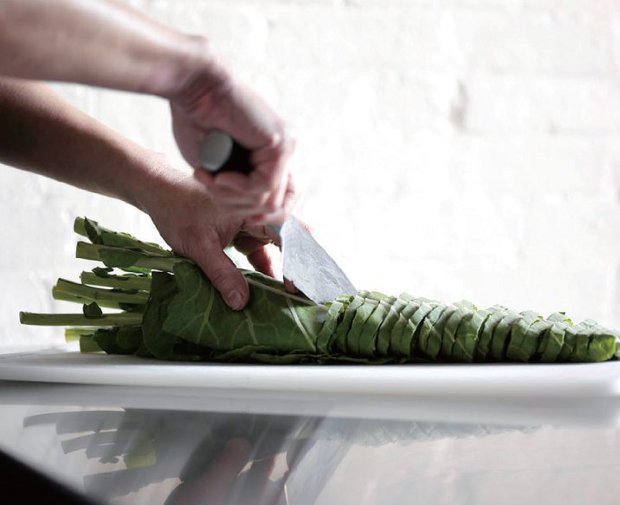KITCHEN SKILLS
To be a good cook, you have to start with the basics. Once you master chopping and cutting techniques, cooking will become a breeze. I find myself in a meditative state when I am preparing foods. I also feel reverence for the fresh, beautiful produce that not only feeds my body but nourishes my soul. When I peel away the skin of a butternut squash, my mood brightens at the sight of its rich orange hue, as if the sun has been hiding in there all along. So here are the basic prep skills that you will need for the recipes in this book. I hope, with a little practice, you will take as much pleasure in wielding them as I do.
BLENDING: Incorporating or mixing two or more ingredients by hand or with a blender.
CHIFFONADE: A term for leafy ingredients, such as basil and collard greens, that are stacked, rolled, and then sliced into thin strips. This technique yields thin, uniform ribbons and minimizes “bruising.”
DICING: Chopping into coarse cubes or pieces, anywhere from 1/8 to ¼ inch. Most recipes call for small, medium, or large dices. You do this by slicing in one direction first, then slicing again crosswise.
EMULSIFYING: Combining two liquids that normally don’t mix together easily, usually by drizzling them very slowly while beating continuously.
JULIENNING: Slicing into thin strips by stacking sliced ingredients, then cutting into the desired thickness and length like matchsticks. You may also use a julienne peeler, which is an efficient time-saver.
MINCING: Chopping into very fine pieces, either by hand, press, or food processor.
PEELING: Using a hand peeler to remove skins as well as create vegetable “ribbons” for salads and garnishes.
PUREEING: Creating a paste or thick liquid by processing ingredients through a blender or pressing them through a strainer.
SHREDDING: Tearing with a hand grater, box grater, or food processor. This is ideal for hard vegetables, such as cabbage and carrots, for easier digestion and absorption.
SLICING: Cutting flat pieces to a desired thickness, in rounds or at a diagonal for more surface area.
SPIRALIZING: Converting vegetables into long, spiral-like strands similar to spaghetti.
ZESTING: Peeling the outer layer of citrus fruits into thin strips.
